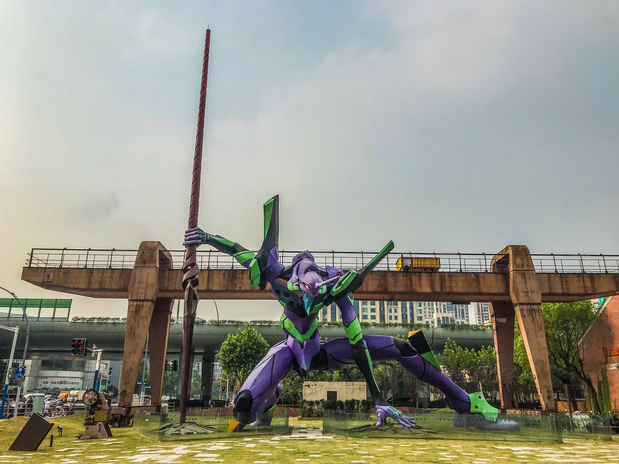*Spoilers ahead*
The Neon Genesis Evangelion franchise has finally drawn to a close. The incredibly complex story of fate, freedom and human psychology shrouded over the guise of huge alien fighting robots known as Evangelions has been recounted and rewritten time and time again, following its original controversially rushed production. After one anime series, several follow-up films and a whole tetralogy series, fans can now rest assured that the show has found a fitting end, just as the show’s creator, Hideaki Anno, intended. Evangelion 3.0+1.0 Thrice Upon a Time (2021), now available in Amazon Prime Video, is also the final installment in the Rebuild of Evangelion series.
The movie picks up right where it left off following Evangelion 3.33 You Can (Not) Redo, after a cataclysmic event known as the Third Impact nearly obliterates human existence. The film’s first act is surprisingly peaceful and introspective, once again introducing the classic trio of Shinji, Asuka and Rei finding themselves in Village-3; a peaceful respite amidst a newly bloodied Earth. The character’s struggles have slightly shifted , but their personalities remain pretty much the same and are echoed throughout scenes that longtime Eva fans will instantly recognize. The main difference is that the trio is physically unable to age due to their experience piloting Evas, and are thus unable to escape their past in a world that has seemingly aged and moved on. At this point, the movie becomes fast paced, but is interrupted with a beautiful sequence of scenery and still images.
The following act moves onto the character of Misato Katsuragi and her recent experience with the loss of her partner, Ryoji Kaji, contrasted with the unnecessarily fanservice-laden interactions between Asuka and Mari Illustrious Makinami. This act also further delves into the evil organization SEELE and the dark intentions of anime’s worst dad, Gendo Ikari.
Gendo Ikari’s search to bring about Human Instrumentality, an ambitious project that seeks total control over human evolution, is about to begin. The stage is now set for the Fourth Impact, and the imminent destruction of what’s left of the planet. But Evangelion would not be Evangelion without epic mecha fight scenes, and the movie makes sure to deliver. For the first and only time in the history of the series, the Eva showdown occurs between father and son, destroyer and savior.
Once more, Shinji gets into the robot as the only hope for humanity. Among the movie’s many Eva scenes, this one takes place in a new dimension known as the Anti-Universe. It’s a riveting struggle that is every bit emotional as it is physical: Shinji gets his ultimate shot at redemption, while Gendo, despite having reached a god-like state, is now seen at his very weakest. The parallels and likenesses between father and son are finally revealed, while Gendo accepts that the reason for his horrible treatment towards Shinji, and subsequent desires for world domination, was the loss of his beloved wife, Yui. While the narration of his past doesn’t excuse his behavior, it does inspire some sympathy from an audience standpoint.
Gendo’s introspection is the main one in this movie, but in true Evangelion fashion, it isn’t the only one explored. The scene transitions into a closer look at the psyches of both Asuka and half-Angel Kaworu. Throughout the sequence, there are a series of evident changes in animation, going from highly detailed character renderings to still images and raw sketches — a technique immortalized by Anno in the original series’ ending. This precedes the climax of the movie, where Gendo ultimately realizes the weight of his mistakes and gives Shinji the opportunity to rewrite the world. In what can best be described as the most emotional and nostalgic scene of the movie, Shinji chooses a world without Evas: a new beginning, a literal and figurative Neon Genesis. The movie resolves on a hopeful note for Shinji and friends, but it also narrates Hideaki Anno’s farewell to a story 26 years in the making.
However, Evangelion 3.0+1.0 Thrice Upon a Time is far from perfect. Some instances of dialogue, especially the ones featuring Mari, prove to be superficial and unneeded, while the use of CGI animation often reaches overwhelmingly excessive levels. On another hand, the bizarre lore that ties together Gendo’s organization, the Evas and the Angels leaves viewers with more questions than answers. Luckily, and despite the complex layers of loaded terminology and biblical references, all of this becomes a subplot in the general context of the movie. This epic conflict may get increasingly difficult to follow at times, but it doesn’t need to be followed in order to grasp the movie’s central themes.
Evangelion 3.0+1.0 Thrice Upon a Time differs from its predecessors because it concludes with a positive look at the future. While other endings, such as the one from End of Evangelion (1997) portray imminent devastation and destruction, 3.0+1.0 flips the script and instead offers optimism and some much needed closure; not just to the protagonist, but to the series’ fans as well as creators. Weaving a tale of healing, hope, and new beginnings, Thrice Upon a Time proves to be the perfect conclusion to the entire Neon Genesis Evangelion storyline.


